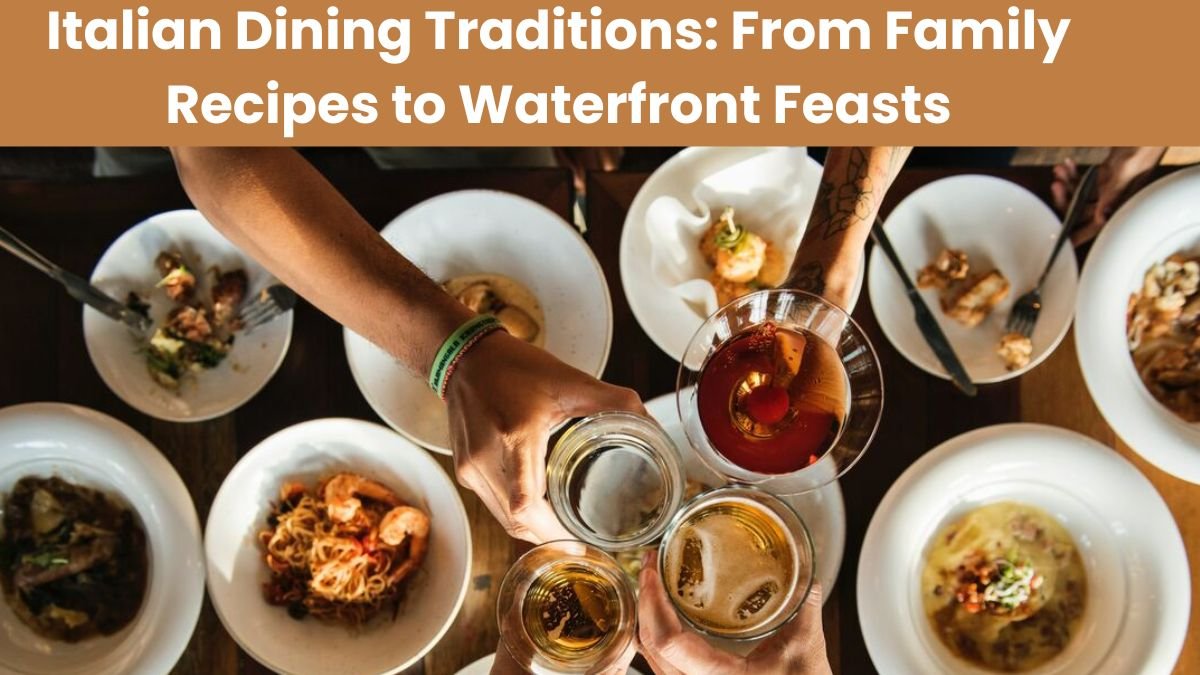Introduction: When we think of Italian food, the first things that come to mind are pizza, pasta and cheese. But have you ever thought that Italian food is not just a recipe, but a tradition, a heritage and a confluence of stories passed down from generations of families? Italian food is not just full of flavour, it also represents social connections, locality and deeply held traditions.
In this article, we will explore how Italian food traditions have evolved from family recipes to modern-day waterfront restaurants. It is an interesting journey – where every dish has a story behind it, and every flavour is filled with the emotions of generations.
Italian Food: A Celebration of Family
Cooking in Italy is not just cooking, it is a ritual. Every family there has its own special recipe that is handed down from grandmother to mother, and then to daughters or sons. Even a simple tomato sauce can taste different in different families.
Sunday Lunch – This is a sacred tradition in every corner of Italy. The whole family sits together and slowly eats a multi-course meal – consisting of antipasti (starters), pasta, meat or fish, salad and then dessert. It is a time to spend together, talk, and strengthen family bonds.
Traditional dishes: Heritage steeped in flavour
Each Italian region has its own special recipes and ingredients. In the north you will find dishes like polenta and risotto, while in the south marinara sauce and olive oil dominate.
Some of the top traditional dishes:
- Lasagna: This layered pasta dish from the Emilia-Romagna region is famous all over the world. It is characterized by layers of beef ragout, bechamel sauce and cheese.
- Osso Buco: This Milanese dish is made by braising veal shank, often served with white wine and gremola.
- Cannelloni: Stuffed pasta tubes – with ricotta, spinach or meat – baked in tomato sauce and cheese.
These dishes are about more than just ingredients, but also emotion. As recipes are passed down from one generation to the next, they retain that “family flavor.”
The importance of seasonality and locality
The beautiful thing about Italian food is that it changes with the seasons. Artichokes and asparagus in spring, tomatoes and basil in summer, mushrooms and pumpkin in autumn, and meats and red wine-based sauces in winter.
Italian chefs and housewives prioritize freshness and local produce. This means that none of the recipes come from the supermarket, but from local markets and gardens.
An Italian dinner by the sea: The magic of waterfront dining
Italy’s coastal cities – such as Amalfi, Venice, Genoa and Sicily – are famous for their seaside restaurants. Dining here is not just a taste experience, but also a blend of views, ambiance and romance.
The sound of the sea waves, the orange hues of the sunset and the sights of fresh fish or pasta with squid-in-the-mouth sauce served in front of you – all combine to create a wonderful experience.
Waterfront dining highlights:
- Focus on seafood: Sea products such as shellfish, octopus, squid, sea bass are cooked simply – to retain their natural sweetness.
- Local wine: The meal is completed with wine made from local grapes, such as Vermentino or Frascato.
- Ambience: Wooden floors, open-air seating, and the blue ocean ahead make for a memorable Italian waterfront meal.
Italian Cuisine and Contemporary Changes
- Italian cuisine has seen some modern changes in recent years, especially as health trends and environmental awareness increase.
- Vegan Italian Options: Traditional dishes are now being prepared in vegan versions, such as tofu lasagna or cashew-based cheese.
- Gluten-Free Pasta: Many restaurants now serve gluten-free pasta due to celiac disease or health concerns.
- Back to Local: Young chefs are now focusing on local recipes and seasonal produce, giving new life to traditional dishes.
Social Connection and Food
In Italian culture, eating is not just an activity, but a collective celebration. Whether it’s a family Sunday lunch, a waterfront dinner with friends, or a community feast at local festivals, food brings people together on every occasion.
This is why Italian food is so popular around the world – because it offers an experience, not just a taste.
Conclusion:
The beauty of Italian cuisine lies in its simplicity, depth and sensitivity. Food is not just about satisfying hunger, it is also a medium through which people connect, share stories and keep traditions alive.
From inherited family recipes to seaside restaurants – the journey of Italian cuisine teaches us that when food is made from the heart, it satisfies not just the body, but the soul as well.
